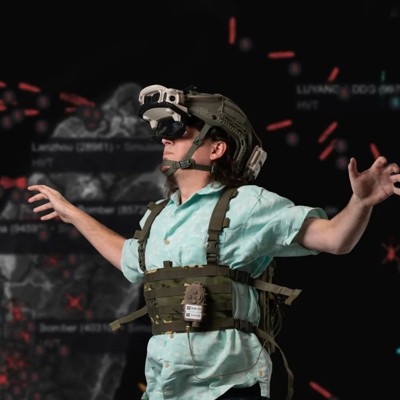The new guard of dominant defense contractors notched big wins over the weekend, as the Army awarded $159 million to Anduril and $195 to Rivet, a startup with Palantir funding, to develop wearable virtual displays as part of the service’s Soldier Borne Mission Command program.
SBMC is a follow-on project to the Integrated Visual Augmentation System, which is limited to a headset, while SBMC includes complementary computers and wearables like watches. In the end, Anduril founder Palmer Luckey told reporters on Monday, there will probably be “dozens” of different headsets under the program, rather than one contractor picked to make one product.
“I actually think that probably most of the SBMC hardware that is sold to the Army over the next 10 years…is not going to be made by Anduril. It’s not going to be made by any of the people who are competing for it,” he said. “It’s going to be made, basically, by adaptations of commercial devices as augmented reality and virtual reality devices proliferate.”
Anduril also has the contract to create the software for SBMC, which will integrate what soldiers see through their displays up through their chain of command.
“I don’t think that any one headset can be the headset that meets every need for every soldier in the Army,” Luckey said. “I think that was one of, actually, the major mistakes…of prior soldier augmentation systems. When you try to build one heads-up display that is the right system for a frontline infantryman, and a rotary-wing pilot, and a logistician, and someone doing training, and you’re trying to make it the right headset for day and for night and for dismounted use, vehicle-mounted use…when you try to be everything to everybody, you have to make so many compromises that you built something that, in the end, is not really the right thing for anyone.”
That said, Luckey has dubbed himself “the world’s best head-mounted display designer,” going back to his creation of the Oculus Rift, an early, commercially-available VR headset.
“There’s nobody better than me, and I know what I’m doing, and I’m going to make sure that we do it the right way. And we’ve already proven that we’re making things that do not make people sick. They do not make them throw up,” Luckey said, alluding to problems with previous IVAS prototypes. “If you’re going to make something somebody wears on their face, there’s a high level of friction and compromise. You need to make it very lightweight. You need to be brutal about the design of the thing, making it extremely comfortable, extremely light. And you need to make sure that it is only enhancing their experience of viewing the world, not degrading it.”
Rivet, similarly, is focusing on “comfort, ruggedization, utility and compliance,” CEO Dave Marra told Defense One on Friday.
Marra said his company’s prototype will integrate an array of voice commands to connect logisticians, maintainers and others on the battlefield and create predictive intelligence.
“These kinds of natural language interactions are the most critical element to enable,” he said. “So you think, ‘I have to control robots, and I have to do it without significant training and learning. I want to recognize nouns on the battlefield that could be a target: that could be a good guy, a bad guy, or another noun on the factory floor. I want to identify anomalies, more importantly, correlate in these data sets.’”
The program will be a key proving ground for the Army’s Transformation-in-Contact strategy, which aims to rapidly develop and field new technology by bringing prototypes into the field for soldiers to test and provide feedback on, and companies can quickly incorporate that feedback.
“I don’t think that there’s an appetite to spend years playing around with these exercises and demos. There is, there is an appetite to get this stuff into real combat as fast as possible, so we can see where it works, see where it falls apart,” Luckey said. “I’m thinking about this as something where we need to be delivering a system that, like other integral products that are being fielded in combat, it needs to work. It can’t break, it can’t put people in danger…It can’t make people cybersick. And that is how we are treating this, regardless of whether it’s named as a prototype sprint.”
Read the full article here








Leave a Reply